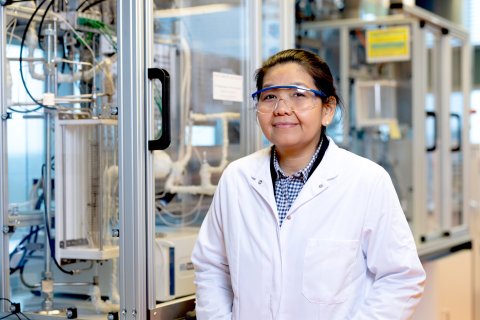On the hunt for hydrogen recipes
Interview with Nong Artrith for Illuster Magazine
There’s a quiet revolution taking place in materials research. When Nong Artrith started her career in physics and chemistry, new chemical reactions were only discovered in the lab. “But we’ve started to make this process faster, safer and cheaper by using computer simulations and artificial intelligence.”

Hydrogen is one of the most promising materials for the energy transition: it can be used for energy storage, and as a base for synthetic fuels. But hydrogen is not without its challenges, interdisciplinary materials scientist Nong Artrith explains. “While hydrogen is already used in industrial applications, it’s not yet efficient and cheap enough to use in smaller quantities, like in our cars. Also, most hydrogen used in industry is currently being produced with fossil fuels, so there’s still a long way to go.”
That’s because green hydrogen is not very easy to make. “The chemical reaction is simple to understand: a water molecule is made up of one oxygen and two hydrogen atoms, so you just need to break it apart to get the hydrogen you want. But splitting up a water molecule into its separate atoms is extremely difficult, it requires a lot of energy. We can make that process easier by adding another material that works as a catalyst. Current catalysts are often made of expensive elements like platinum or iridium, so I want to find a much cheaper catalyst that works just as well.”
Promising recipes
However, the search for a cheaper catalyst is a difficult puzzle. “We’re working on new catalysts based on cheap materials like iron, copper, nickel or sulfur. But there are so many ways to combine these elements, in different quantities, and under different experimental conditions like temperature and pressure.”
Fortunately, developments in big data, computing, and artificial intelligence have opened up a new, smarter way to work. Instead of endlessly testing millions of different catalyst options in the lab, Nong takes a different approach: she has built an artificial intelligence system that can predict chemical reactions. “We’ve trained the system with the physics and quantum mechanics of chemical reactions, and added as much relevant experimental data as possible. You can now ask the system how to make better catalysts for hydrogen production, for example, and it will give you a few promising recipes. We still need to test those catalysts in the lab to see if they work in the real world. But since the AI system has already made a first selection, we have fewer failed experiments. That makes materials research faster, safer and cheaper.”
Joining forces
When asked about her vision for the future of her research field, Nong doesn’t hesitate: “One way to really improve our AI models would be to train them with as much experimental data as possible, from chemistry research groups worldwide. That’s why open science is so important. I’m proud that here at Utrecht University we’re leading the way, and lately I am noticing that more research groups are joining this movement. My own AI models and database are already open access.”
The importance of joining forces also extends to the world outside academia. “We need to talk about sustainability with our parents, our cousins, our youngers – our whole village. Talk to them about what they can see: why is it so warm? Why are floods happening more often? This makes it easier for them to understand the effects of climate change and the importance of sustainability. Many people feel like they can’t do anything about it. Or they have other things on their mind, maybe they have to work seven days a week to support their family and don’t have time for activism, or they can’t afford more expensive climate-friendly products. But it’s important to let them know that they can still have an impact by voting. If we work together, we can elect leaders that make the right decisions.”
Source: Illuster april 2023
Nong Artrith doesn’t let borders hold her back, either between countries or between research fields. After a Master’s in physics in Thailand and a PhD in theoretical chemistry in Germany, she moved to the US for research positions at MIT, UC Berkeley and Columbia. In 2021, she joined Utrecht University as a tenure-track Assistant Professor at the Debye Institute for Nanomaterials Science.

